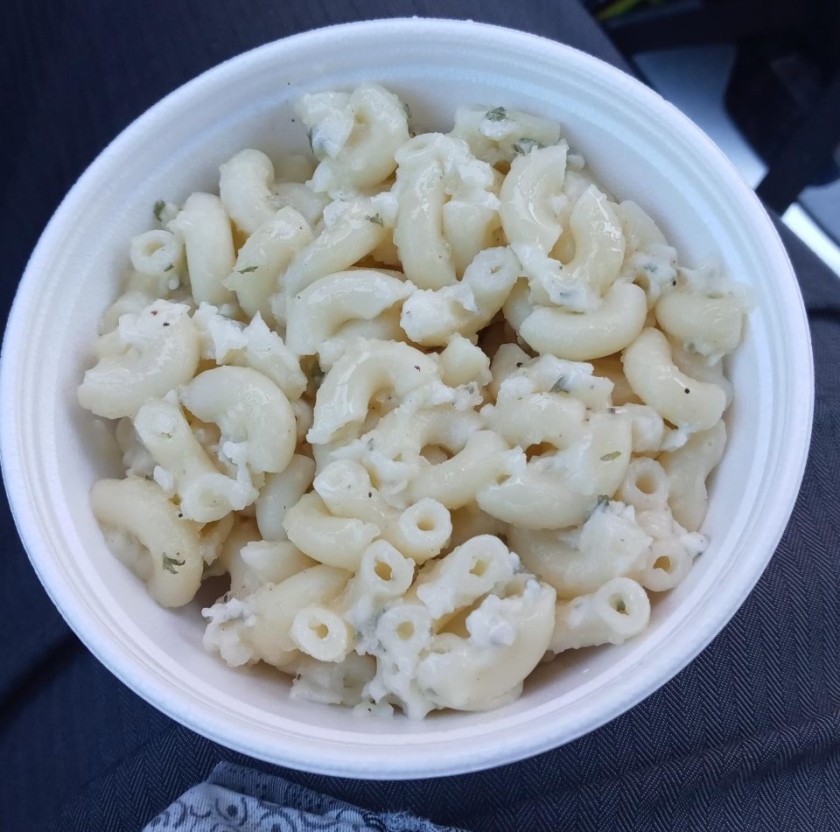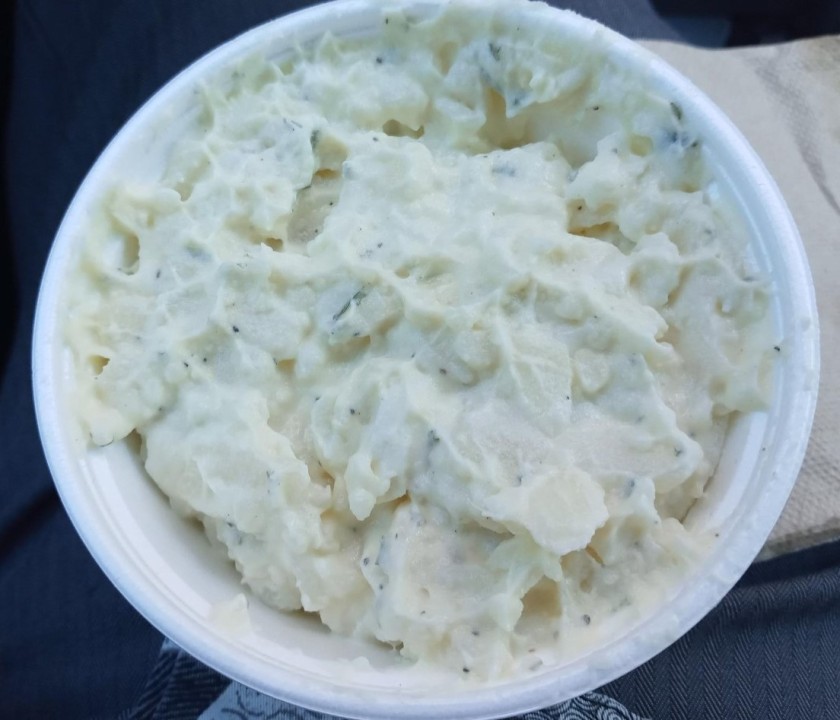It has been a long time since my last installment of The ‘Dines List, the recurring Saboscrivner feature where I review different tinned sardines and other tinned seafood. Before you recoil in disgust or make that “Flehmen Response” face that is so funny when cats do it, I want to once again extol the virtues of the humble sardine. These tiny fish are near the bottom of the food chain. They are extraordinarily healthy, full of omega-3 fatty acids, no mercury like so much canned tuna, pure protein, and mostly environmentally sustainable, although I have been reading articles recently about sardines being the victim of overfishing, both in the Pacific Ocean and near the setting of this latest ‘Dines List.
Plus, now sardines are trendy “hot girl food,” so even though I am the furthest thing from a hot girl (not a girl, not hot unless you have a thing for bear types, and then the jury is probably still out), I am pleased that a thing I like is finally being appreciated and enjoying a moment in the cultural zeitgeist, just like how the last 20+ years of superhero movie mania has validated another one of my lifelong loves. So now, on to the ‘dines!
Beautiful Portugal, the westernmost country in Europe, lies on the western coast of the Iberian peninsula, next door to Spain. Historically, Portugal was responsible for a lot of seafaring, trading, and fishing, and to this day, fish and seafood are a major part of the typical Portuguese diet. Only Japan and Iceland consume more fish per capita than Portugal! Many of the locally caught sardines, tuna, and other fish are processed (tinned) and exported all around the world.
After my last ‘Dines List feature, where I reviewed sardines from Morocco, Portugal’s neighbor across the sea, I decided to do a round-up of all the Portuguese sardines I could find, to review them all and point out the good, the bad, and the stinky.
I discovered these Nuri spiced Portuguese sardines at Lotte Plaza Market, the fantastic and huge pan-Asian supermarket in West Orlando, a super-fun place for local foodies to shop and eat. You can have a delicious meal at one of the many Asian restaurants in the food court and then stock up on groceries and snacks, but don’t forget the Nuri ‘dines! 
These had a really nice heat from piri-piri peppers, and they also included carrot, cucumber, laurel(!), and clove in the seasoning. 
Since I had never tried the Nuri sardines before, I ate them plain, but for some reason I plated them instead of devouring them straight out of the tin. Note the single carrot slice, single pepper, and single cucumber slice, which was more like a thin pickle slice at this point. I really liked these and would get them again. They were surprisingly, pleasantly spicy!
I must have bought these Bela sardines a long time ago, maybe at Fresh Market. This brand tends to cost more than other sardines, so I must have gotten the can on sale. Unlike the Nuris above, these were lightly smoked, and the label makes clear they were packed in organic extra virgin olive oil. Like the Nuris, they were also seasoned with piri-piri peppers, which is a delicious, piquant pepper that adds a nice kick to foods without being overwhelmingly hot. 
These Belas were much nicer-looking than most other tinned sardines, still retaining their iridescent silvery skin (which is perfectly tasty, don’t worry). I typically avoid boneless, skinless ‘dines, because the bones give a nice, light crunch and are packed with calcium, and ‘dines with skin are more attractive and taste better, at least to me. 
I made a Bela sandwich on a toasted bialy, with some sliced onion, fresh cilantro, Trader Joe’s piri-piri hot sauce (the orange sauce on the left), and crispy French-fried onions over the ‘dines themselves, with cream cheese beneath them. Thankfully I’m still wearing a mask in public three years into the pandemic, which allowed me to eat a stanky sandwich like this with a clearer conscience. It was delicious, though. All the flavors went well with these beautiful Belas.
I believe I found these Bon Appetit Portuguese sardines at Green Hills Supermarket, a wonderful Eastern European grocery store in Altamonte Springs, Florida, which is heaven for tinned fish aficionados. They stock all kinds of pickled herring, smoked Latvian sprats, and countless brands of tinned and bottled ‘dines from around the world, particularly European brands. 
After draining the “hot olive oil,” these weren’t that much to look at either, and to be completely frank, I barely remember them. I think they had kind of a dry taste, like you could chew them forever and not much would happen (like too many people’s mamas’ pot roast). 
I served the Bon Appetit sardines on homemade potato blinis, fancy little savory pancakes I learned how to make after first trying them at Bern’s Steak House in Tampa. The blinis were definitely better than the ‘dinis. 
I always see this Porthos brand at Fresh Market, usually priced higher than most supermarket ‘dines — maybe even $6 or $7 per can? I know myself, and I know I would not have bought this unless it was on sale for $5 or under. What I didn’t catch was that the ‘dines were packed in brine rather than some kind of oil, so caveat emptor.
Not very pretty, are they? I would have expected more from the fancy-pants Porthos brand. They were smellier than most canned ‘dines just because they were packed in brine rather than oil. I grew up in a house where we ate canned tuna packed in water as a regular staple food, and I ate it throughout college and grad school, pretty much until I met my wife and the smell emanating from a can I opened made her throw up immediately, with no warning whatsoever. I never bought canned tuna in water again, and while she might not share my love of canned sardines, the smell never nauseates her either. But these were fishy and funky, and I wouldn’t buy this bougie brand again. I probably mixed them with Duke’s mayonnaise and one of the many mustards in my collection to make sardine salad, a tribute to the tuna salad that sustained me through far too many bachelor pads and degrees. 
I think I found these Tome sardines at Enson Market, another Asian supermarket at 5132 W Colonial Dr, Orlando, FL 32808, maybe five minutes west of the aforementioned Lotte Plaza Market.
The picture on the box shows little sliced vegetables, including what looks like a pickle slice and maybe a red pepper. I think these ‘dines had a bit of a sour, pickley note, but I must admit, I don’t recall the vegetables coming in the can. I would have mashed these up into sardine salad with a dollop of mayo, and I chopped some Grillo’s Pickles into it (my favorite brand, from my Plethora of Pickles review). 
The Tome sardines in spicy olive oil with chili were better, but still pretty standard.
They looked more appealing in the can with their shimmering silvery skin attached. 
I recall these being good enough to eat straight up, after draining the oil (never down the drain, folks!). 
Trader Joe’s Wild Caught Sardines in Olive Oil with Smoke Flavor are a terrific value for Portuguese sardines, and surprisingly tasty on their own or in anything. That little bit of smokiness helps immensely.
Like so many of the others, I ate these plain, straight out of the can after draining most of the oil, probably standing over the sink at home. They definitely aren’t the prettiest ‘dines, but I would get them again. 
This is my most recent ‘dine discovery: the Angelo Parodi brand, which I found for the first time visiting Filippi’s Pizza Grotto in San Diego’s Italian Village, a wonderful old-school Italian-American restaurant attached to an equally old-school Italian grocery store. You have to walk through the tiny market to get to the restaurant in the back, with red and white checkered tablecloths, candles melted into chianti bottles, the whole deal. I had great pizza and a good Italian sub (which I should really get around to reviewing), but I couldn’t walk through an Italian market without bringing home some edible souvenirs, so I grabbed two tins of the Angelo Parodi ‘dines in olive oil with chili peppers. Despite the brand name and the source, they are also products of Portugal, not Italy. 
I already drained the orange oil in this photo, but they looked beautiful — nice and meaty, silvery skin intact, packed tightly, definitely pleasing to the eye. 
And here they are. Thrill to my half-assed plating with some fresh, house-made Ceili chips (potato chips) from Fiddler’s Green, our favorite Irish pub in Winter Park, Florida. Tonight I brought my wife home her favorite chicken tenders and the chips, but I knew I was having the Angelo Parodi ‘dines so I could finally finish this mega-review of Portuguese sardines. They were surprisingly spicy, even drained of the oil, but very firm, meaty, and on the salty side, especially paired with the potato chips. That was not the best choice — some crusty Italian bread would have been better, but crusty Italian bread would make almost anything better.  As usual, the included chili peppers were sad sacks of seeds, not really worth trying to eat. But even though I’ve never seen Angelo Parodi products for sale in Florida (not even at Mazzaro’s Italian Market in St. Petersburg or Doris Italian Market in South Florida, two wonderful places I desperately need to revisit and review), I would definitely get these sardines again.
As usual, the included chili peppers were sad sacks of seeds, not really worth trying to eat. But even though I’ve never seen Angelo Parodi products for sale in Florida (not even at Mazzaro’s Italian Market in St. Petersburg or Doris Italian Market in South Florida, two wonderful places I desperately need to revisit and review), I would definitely get these sardines again.
Finally, this isn’t a can of sardines at all, but rather Cole’s smoked rainbow trout that happens to be from Portugal, so I’m including it. My wife loves trout, and I often pan-fry pecan-crusted (fresh) trout filets for her. She does not share my love of sardines, but this is one of the very few canned fish she will actually eat. It is absolutely freakin’ delicious, and I include it here to go along with the Portuguese theme, and to for the sardine skeptics who might be open to other tinned treats. If any canned fish is going to win over the masses, this is the one. 
While the canned rainbow trout filet doesn’t look like much, it flakes apart beautifully, and it is tender and moist and lightly smoky, and not “fishy” at all. Here is the before pic:

And the after pic is below. I enjoyed this tin with a Gabila’s frozen potato knish, thawed in the microwave and then heated until crispy in the toaster oven. I usually use these frozen Gabila’s knishes as mustard delivery devices, as in my last Cutting the Mustard mega-review, where I went into more detail on the brand and its storied history. But the knish went so well with the smoky, flaky, oily, rich trout, I refrained from adding mustard or any other condiments. It didn’t need them. Trout, trout, let it all out, this is the fish I can’t do without! 
I worry now about the reports of the entire Portuguese sardine fishing industry being in danger, because they are such a major part of the Portuguese diet, as well as the national economy. I always thought eating sardines was morally superior to consuming larger fish that are higher up in the food chain, but now it sounds like we all need to get used to cutting back. The Monterey Bay Aquarium’s SeafoodWatch website even says Moroccan-caught sardines are a good alternative, but it is better to avoid Portuguese-caught sardines. Of course, I started writing this ‘Dines List column well almost two years ago, and I fully admit I had no idea when I started. I strive to sustain a sundry sardine stash at the Sabo-Shelter, but once I eat my way through those, I want to be part of the solution, not part of the problem.




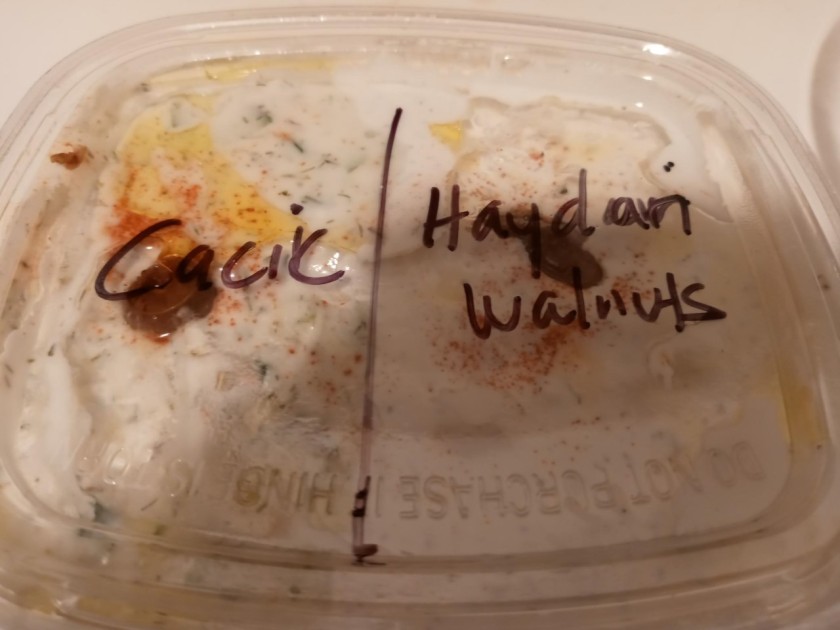 The word “Zeytin” is Turkish for olive, a favorite delicacy of Chef Z, and we noted that each dip was topped with a kalamata olive. I made sure my wife ended up with all of those.
The word “Zeytin” is Turkish for olive, a favorite delicacy of Chef Z, and we noted that each dip was topped with a kalamata olive. I made sure my wife ended up with all of those.







 The moussaka came with a mountain of that wonderful buttery rice pilaf with orzo, which we both loved.
The moussaka came with a mountain of that wonderful buttery rice pilaf with orzo, which we both loved. I was impressed that it essentially came with a whole side salad, with chopped romaine lettuce, tomatoes, red onions, cucumbers, and parsley tossed in a very light vinaigrette dressing, which you can roll up inside the lahmacun to eat, like a veggie wrap with meat on the inner wrapping. But there was so much salad, that even after eating all three lahmacun pieces with it, I was able to pack the rest in my work lunch the following Monday. (I also ate the lemon wedges like orange wedges, which is what I usually do with lemon wedges.)
I was impressed that it essentially came with a whole side salad, with chopped romaine lettuce, tomatoes, red onions, cucumbers, and parsley tossed in a very light vinaigrette dressing, which you can roll up inside the lahmacun to eat, like a veggie wrap with meat on the inner wrapping. But there was so much salad, that even after eating all three lahmacun pieces with it, I was able to pack the rest in my work lunch the following Monday. (I also ate the lemon wedges like orange wedges, which is what I usually do with lemon wedges.)
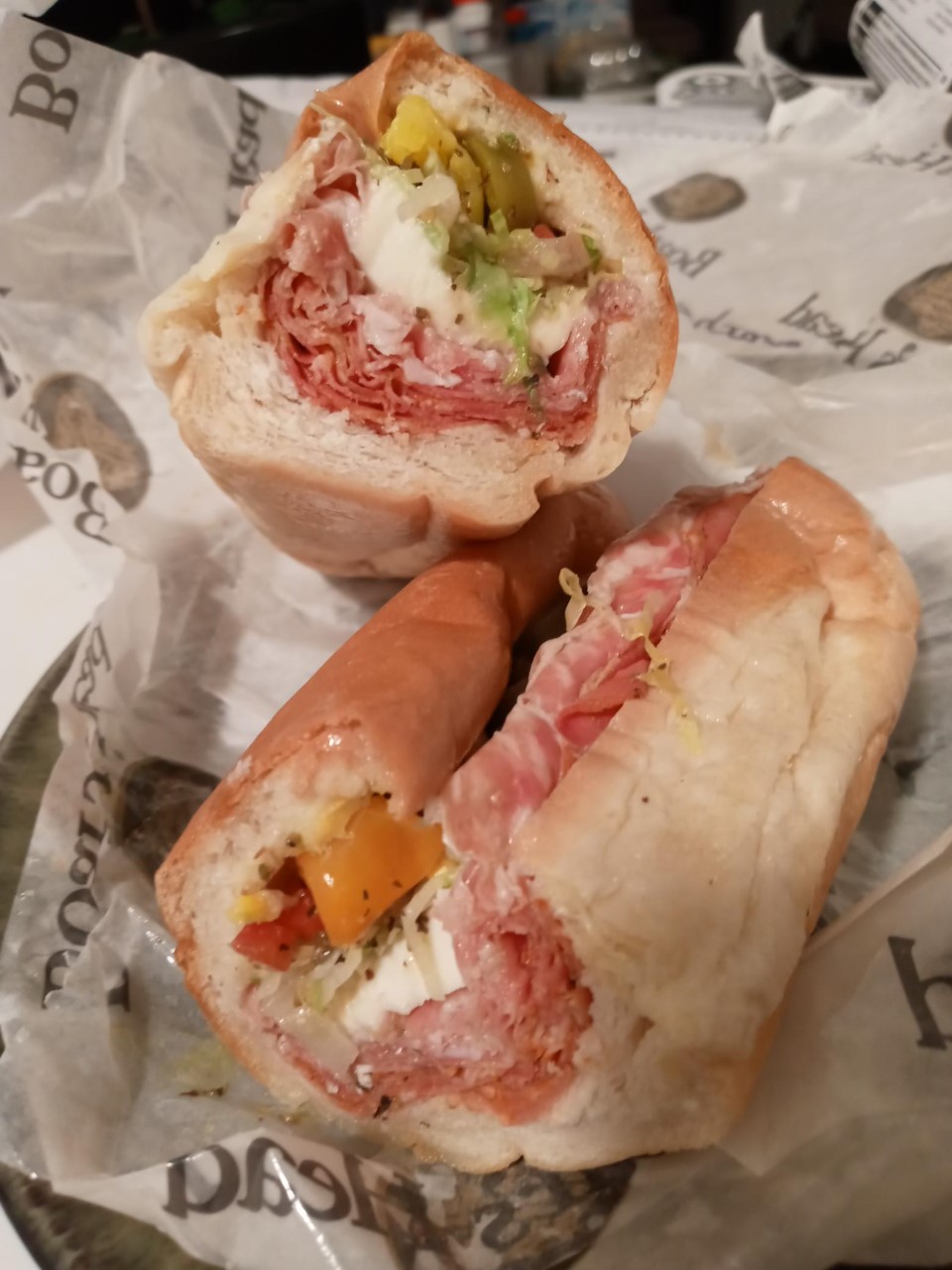
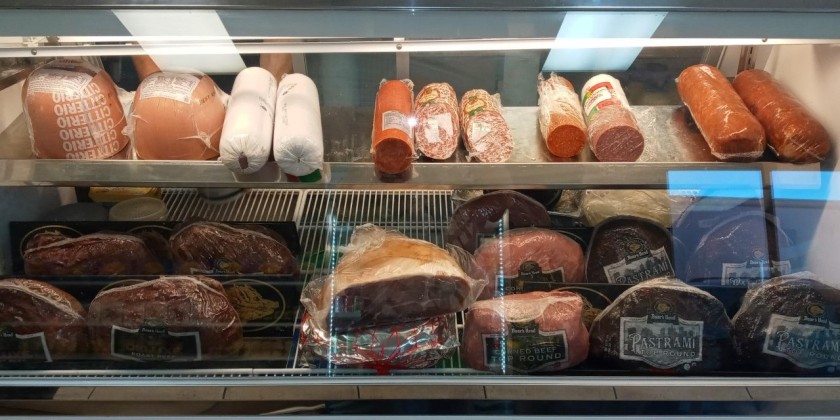
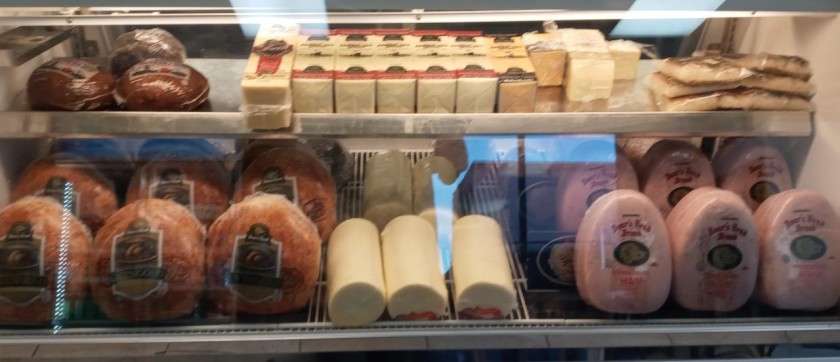
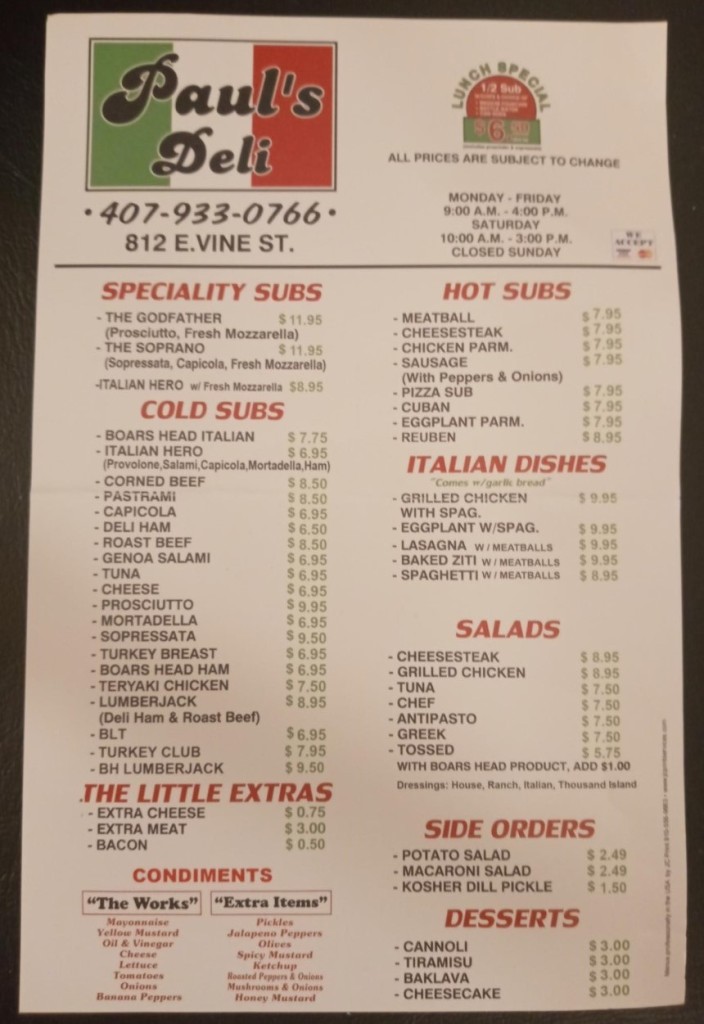

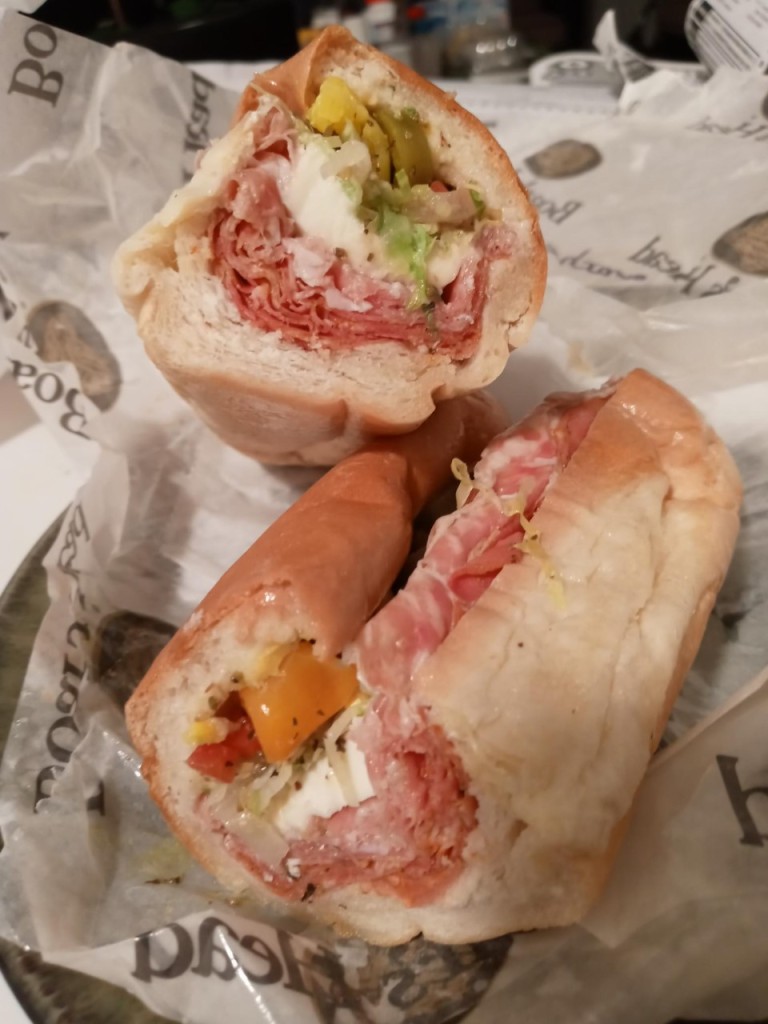 Both of these were cold subs, by the way. I am not a fan of my cured Italian meats served hot ‘n’ greasy. I like the flavors and textures so much better when they are cold.
Both of these were cold subs, by the way. I am not a fan of my cured Italian meats served hot ‘n’ greasy. I like the flavors and textures so much better when they are cold.